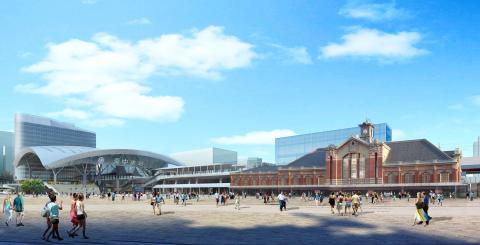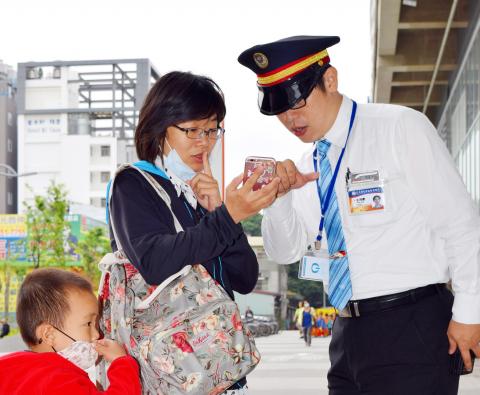Sporting his Taiwan Railways Administration cap, Taichung station director Wang He-chieh ( 王河傑 ) gets asked a lot of questions these days by Taichung commuters, with one of the most popular being, “Where are the trains?”
The confusion is short-term, railways officials hope, as travelers get accustomed to Taichung’s new NT$221 million elevated train station. Opened in October, the sleekly-designed station replaces the adjoining century-old former station.
“It’s definitely better than before,” said Li Bing-Hsing (李秉興), after arriving by train from Miaoli. “It’s not that crowed and a lot more convenient.”

Photo courtesy of Shu Chang & Associates, Architects
JAPANESE ARCHITECTURE
Preserving the past while planning for the future is what architect Shu Chang (張樞) hoped to achieve when designing the new station.
“I tried to respect the old building as much as possible,” said Chang, a Taichung native, whose company was subcontracted by CECI Engineering Consultants. “It’s one of the better examples of Japanese-era architecture.”

Photo: John Evans
To better show off the historic building, the less-sightly recent additions will be removed. The original platforms and tracks, however, will remain as part of a new railway museum that will be completed soon.
The new station’s second-floor concourse was designed to be “open air” to take advantage of Taichung’s usually mild weather, said Chang, who also teaches architecture at National Taiwan University.
A large pedestrian area on the first floor will be a multi-use public space, he said.
Chang said the new station is intended to embrace the concept of urban design, adding, “It will totally redesign that part of the city.”
With weekday ridership at 60,000, passengers at the old station often jostled for space while waiting for their train.
And when construction is completed at the end of next year, the new station will be 33,325 square meters, more than 30 times the size of the original station.
In addition, the new station will be able to accommodate more trains with its five tracks and three platforms. Currently, there are three tracks and two platforms, the same number as at the old station.
While businesses inside the new station are yet to open, train officials said convenience stores and other shops are expected to open within the next few months.
The elevated station and the adjoining tracks will help connect the city as a whole, railway officials said. A series of street-level railroad crossings had effectively cut off portions of the city’s southern and eastern areas.
The new Taichung station is just one in a series of elevated train stations and rail lines winding its way through the city.
“I’m proud of this project,” said Wang. “We’re revitalizing this area of the city.” Railway and city officials hope the new station will help create more convenience for travelers with a boom in business opportunities.
BUSINESS OPPORTUNITIES FOR SOME
The construction of the new station has already been an economic shot in the arm for an older, working-class section of the city.
From tea stands to sandwich shops, business is flourishing adjacent to the new station.
“I’m very happy. It’s 50 percent better,” said Roy Chiu (邱富崑), manager of a nearby tea stand. The upturn in business has allowed his employees to work additional hours for bigger paychecks, he said.
And while businesses near the new station are finding an economic resurgence, on the opposite side of the tracks it’s the flip side.
Convenience stores nearby the old station have reported a drop in business by about one-third.
Jiang Ming-wei (蔣名瑋) has seen the slowdown firsthand. Jiang works at a scooter parking garage a short walk from the old station where weekday business is off only slightly, but on weekdays it has plummeted 50 percent.
OLD TRAIN STATION, NEW MUSEUM
The old train station, built during the Japanese colonial era, will be leased to a private company and turned into a train museum and exhibition space, and rebranded Taichung Railway Cultural Park.
Preserving the old building, which is a National Heritage Site, is a priority, train officials said.
“The atmosphere will be a mix of old and new,” said Sophia Lin (林于茜), a TRA spokesperson.

June 9 to June 15 A photo of two men riding trendy high-wheel Penny-Farthing bicycles past a Qing Dynasty gate aptly captures the essence of Taipei in 1897 — a newly colonized city on the cusp of great change. The Japanese began making significant modifications to the cityscape in 1899, tearing down Qing-era structures, widening boulevards and installing Western-style infrastructure and buildings. The photographer, Minosuke Imamura, only spent a year in Taiwan as a cartographer for the governor-general’s office, but he left behind a treasure trove of 130 images showing life at the onset of Japanese rule, spanning July 1897 to

In an interview posted online by United Daily News (UDN) on May 26, current Chinese Nationalist Party (KMT) Chairman Eric Chu (朱立倫) was asked about Taichung Mayor Lu Shiow-yen (盧秀燕) replacing him as party chair. Though not yet officially running, by the customs of Taiwan politics, Lu has been signalling she is both running for party chair and to be the party’s 2028 presidential candidate. She told an international media outlet that she was considering a run. She also gave a speech in Keelung on national priorities and foreign affairs. For details, see the May 23 edition of this column,

The Taiwan People’s Party (TPP) on May 18 held a rally in Taichung to mark the anniversary of President William Lai’s (賴清德) inauguration on May 20. The title of the rally could be loosely translated to “May 18 recall fraudulent goods” (518退貨ㄌㄨㄚˋ!). Unlike in English, where the terms are the same, “recall” (退貨) in this context refers to product recalls due to damaged, defective or fraudulent merchandise, not the political recalls (罷免) currently dominating the headlines. I attended the rally to determine if the impression was correct that the TPP under party Chairman Huang Kuo-Chang (黃國昌) had little of a

At Computex 2025, Nvidia CEO Jensen Huang (黃仁勳) urged the government to subsidize AI. “All schools in Taiwan must integrate AI into their curricula,” he declared. A few months earlier, he said, “If I were a student today, I’d immediately start using tools like ChatGPT, Gemini Pro and Grok to learn, write and accelerate my thinking.” Huang sees the AI-bullet train leaving the station. And as one of its drivers, he’s worried about youth not getting on board — bad for their careers, and bad for his workforce. As a semiconductor supply-chain powerhouse and AI hub wannabe, Taiwan is seeing